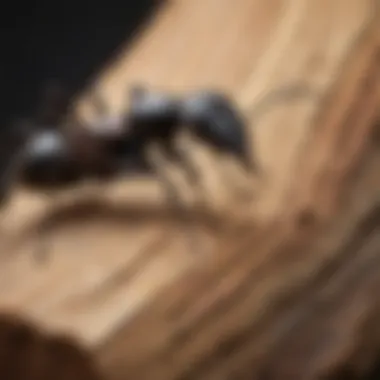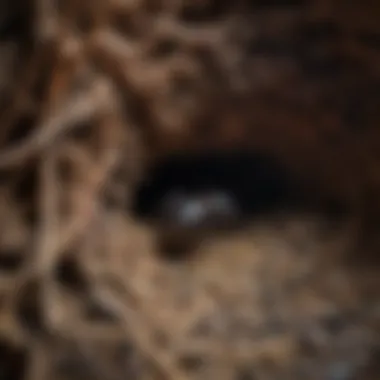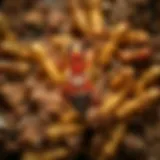Expert Insights on Managing Carpenter Ant Infestations


Intro
Carpenter ants are not just a nuisance for homeowners; they can cause serious structural damage if left unchecked. Understanding their behavior and lifecycle is essential for effective management. This article provides a detailed exploration of carpenter ants, emphasizing identification, prevention, and both DIY and professional control methods. By being informed, homeowners can take proactive steps to protect their property from potential infestations.
Pest Identification
Identifying carpenter ants early is crucial in managing an infestation effectively. Different species can invade homes, but several features help differentiate carpenter ants from other pests.
Common Household Pests
Carpenter ants (Camponotus spp.) are often confused with termites, but they differ significantly in behavior and nesting habits. Carpenter ants are known for their black or bicolor bodies, while termites typically have a lighter, more uniform color. Unlike termites, which consume wood, carpenter ants excavate it to create nests.
Signs of Infestation
Look for certain telltale signs that indicate the presence of carpenter ants:
- Frass: This wood shavings are left as evidence of nesting activity.
- Hollow Sound: Tapping on wooden structures may produce a hollow sound, signaling internal damage.
- Trail Marks: Seeing ants marching to and from their nest may indicate an established colony.
Understanding the signs of an infestation is vital. Early detection leads to more effective control.
Prevention Methods
Taking preventive measures can significantly reduce the risk of carpenter ant infestations.
Environmental Modifications
Changing the environment around your home can deter carpenter ants:
- Remove Moisture: Carpenter ants are attracted to damp, decaying wood. Fix leaks and remove standing water.
- Trim Vegetation: Keeping trees and shrubs trimmed can prevent ants from gaining access to your home’s exterior.
Home Maintenance Tips
Regular home maintenance plays a key role in prevention. Consider the following tips:
- Seal Cracks: Fill cracks and holes around windows, doors, and foundations to prevent entry.
- Store Firewood Properly: Keep firewood stacked away from the home and off the ground.
DIY Pest Control Solutions
If you detect a carpenter ant presence, there are several DIY options that homeowners can explore before seeking professional help.
Natural Remedies
There are various natural remedies that can be effective:
- Vinegar Solution: A mixture of equal parts vinegar and water can disrupt scents used by ants for navigation.
- Diatomaceous Earth: Sprinkling this powder around entry points can help eliminate ants without harmful chemicals.
DIY Traps and Barriers
Creating traps can aid in monitoring and controlling carpenter ants:
- Boric Acid Bait: Mix boric acid with sugar water to attract and kill ants.
- Sticky Traps: Place sticky traps near ant trails to catch them effectively.
Taking the right steps to manage carpenter ants will not only protect your home but can also provide peace of mind. From identifying these pests to exploring both preventive measures and DIY solutions, homeowners are equipped to handle potential infestations with confidence.
Preface to Carpenter Ants
Carpenter ants present significant challenges for homeowners, primarily due to their nesting behaviors and the potential structural damage they can inflict. Understanding carpenter ants is crucial in combating their infestations effectively. This section provides foundational knowledge that aids in identifying, managing, and eventually eliminating these pests from residential spaces.
Defining Carpenter Ants
Carpenter ants, scientifically known as Camponotus, are among the largest species of ants in North America. They can be easily identified by their black or bicolored bodies, which can vary in length from 1/4 to 1 inch. Unlike termites, carpenter ants do not consume wood; instead, they excavate it to create intricate networks of tunnels for their nests. This behavior often results in considerable damage to wooden structures if left unchecked.
Carpenter ants thrive in moist environments, commonly nesting in decaying wood. Homeowners should be vigilant as these ants can often signal more extensive moisture problems within the home. Their adaptability to various environments makes them significant pests that can easily settle into residential settings, leading to challenges in control and management.
The Life Cycle of Carpenter Ants
The life cycle of carpenter ants encompasses four critical stages: egg, larva, pupa, and adult. Each stage plays an important role in the colony's dynamics and functionality. The queen is pivotal, laying hundreds to thousands of eggs each year, ensuring the continuity of the colony.
- Egg Stage: This stage involves tiny, whites eggs that are produced by the queen. They take about a week or more to hatch.
- Larva Stage: Once hatched, the larvae are fed and cared for by worker ants. This stage can last several weeks, depending on environmental conditions and food availability.
- Pupa Stage: After the larval stage, the ants will pupate. This stage is when they transform into adult ants. Development in this stage typically lasts 10 to 14 days.
- Adult Stage: After reaching adulthood, carpenter ants can live for several years. Adult insects are the main workers and foragers, responsible for gathering food and maintaining the nest.


The overall life cycle, from egg to adult, can take several months, depending on environmental factors. Understanding this cycle is essential, as it informs pest management strategies, allowing homeowners to target specific life stages for maximum effectiveness in control efforts.
By comprehensively understanding carpenter ants' life cycle and behaviors, homeowners can better forewarn and manage potential infestations.
Identifying Carpenter Ants
Identifying carpenter ants is important in controlling their populations and preventing potential damage to your home. This involves recognizing both their physical characteristics and signs of infestations. By understanding how to properly identify these pests, homeowners can implement timely and effective measures to address the problem.
Physical Characteristics
Carpenter ants have distinct physical traits that can aid in their identification. They are typically larger than common household ants, measuring between 1/4 to 1/2 inch in length. Their bodies are usually black or reddish, and they can have some white or yellowish markings. Notably, carpenter ants possess a smooth, rounded thorax, which differentiates them from other ant species that may have spines or bumps.
Their antennae are segmented and bent, which is another key distinguishing feature. Understanding these characteristics makes it easier for homeowners to identify carpenter ants before they escalate into an infestation. When spotted early, the chances of effectively managing the situation increase significantly.
Signs of Infestation
Identifying the signs of a carpenter ant infestation is crucial for timely intervention. Homeowners should be vigilant for specific indicators that can signal a problem.
Frass
Frass is a telltale sign of carpenter ant activity. This material resembles wood shavings and is made up of the debris created by these ants as they excavate wood to create nests. It commonly accumulates near potential nest sites. Recognizing frass is beneficial because it provides insight into where the infestation may be most concentrated. This can help in effective targeting of control methods. Detection of frass can indicate an existing nest nearby, offering a lead on where to focus efforts to eliminate the pests.
Noisy Activity
Carpenter ants are known for producing distinctive sounds, especially at night when they are most active. This noise is often described as a faint rustling or tapping noise, which can indicate the presence of a colony. The identification of noisy activity can be critical, as it often hints at a more significant infestation. Monitoring sound levels in areas of suspect activity allows homeowners to effectively pinpoint the location of the nest for further treatment.
Visible Trails
Visible trails are another indicator of carpenter ant activity. These paths might consist of ants moving back and forth, often leading towards food sources or their nests. Homeowners are encouraged to observe these trails, as they can serve as direct routes to where the ants are foraging. Tracking these trails is advantageous because it can reveal the extent of the infestation and highlight entry points that need sealing. Identifying visible trails is key in devising a strategic approach to manage and eliminate the infestation effectively.
Understanding these physical characteristics and signs of infestation provides homeowners with the tools they need to respond swiftly and effectively to carpenter ant issues.
Behavior and Habitat of Carpenter Ants
Understanding the behavior and habitat of carpenter ants is essential for managing infestations effectively. These ants exhibit specific nesting and feeding habits that influence their presence within homes. By learning their preferences and behaviors, homeowners can take proactive steps to mitigate potential damage and limit future infestations.
Nest Location Preferences
Carpenter ants do not actually consume wood; instead, they excavate it to create nests. They prefer areas that offer moisture and shelter. Common sites include:
- Decaying wood: Areas that are damp and rotting are ideal for these ants.
- Walls and ceilings: Hidden spaces within structures provide a safe environment.
- Trees and stumps: Natural habitats like these can serve as nesting sites, especially if they show signs of decay.
Identifying these locations is crucial for homeowners. If there are indications of carpenter ants, such as frass or sawdust, it is advisable to inspect these areas thoroughly. Awareness of where the nests are can help in implementing targeted solutions.
Feeding Habits
Carpenter ants are omnivorous and have quite diverse feeding habits. They primarily feed on:
- Sugary substances: They are attracted to honeydew produced by aphids and other insects.
- Protein sources: They may consume insects or other protein-rich materials.
- Foods left out: A common occurrence in homes is when these ants invade kitchens or pantries in search for leftovers or sugar.
Their feeding patterns can lead them back to nests, further complicating an infestation. Understanding these habits aids in the development of effective control methods. Homeowners can limit food sources by maintaining cleanliness and sealing food securely.
"Proactive management of feeding sources can significantly reduce the appeal of a home to carpenter ants."
Ants are highly social creatures. They work in groups to transport food back to their nests. Knowing this behavior can also shape a homeowner's approach to pest management. Setting baits near trails or foraging sites may be an effective strategy to disrupt their natural flow.
Overall, having insight into carpenter ants' behavior and habitat is pivotal in assessing the manageability of any infestations. By addressing these aspects, homeowners are better equipped to implement preventive measures and effective control strategies.
Are Carpenter Ants Easy to Get Rid Of?
Addressing the manageability of carpenter ants is crucial for homeowners facing infestations. Knowing whether these pests are easy to eliminate can shape strategies. Understanding the factors that influence manageability aids in selecting appropriate methods for control. Each method comes with its own level of effectiveness, depending on the situation, and identifying the right approach is key to effective management.
Factors Influencing Manageability
Extent of Infestation
The extent of infestation significantly influences how manageable carpenter ants are. When an infestation is small, it can be easier to control. In contrast, large populations may require more aggressive methods. Property owners should assess the level of infestation before deciding on a course of action. A small number of carpenter ants may indicate a limited nesting site. This presents an opportunity for localized treatment.
However, larger colonies can cause structural damage if left unchecked. Understanding the scope helps prioritize efforts and allocate resources effectively. Methods to gauge infestation levels include monitoring signs like trails and frass. Scalability of control measures should take into account the infestation's size.


Access to Nesting Sites
Another critical aspect is the access to nesting sites. Carpenter ants typically build nests in wood structures. Accessibility to these locations affects how easily they can be eliminated. If nests are hidden, detection becomes challenging. Homeowners need to conduct thorough inspections of their property. This includes checking attics, wall voids, and basements.
If nesting sites are located easily, it facilitates targeted treatment. However, if they are concealed, this may prolong the elimination process. The hidden nature of the nests means that simple exterior treatments may not suffice. They might only target the foraging ants, while the colony remains intact.
Environmental Conditions
Environmental conditions play a role in manageability as well. Carpenter ants are influenced by habitat, moisture levels, and temperature. High humidity levels often favor their nesting and feeding habits. Therefore, managing these environmental factors becomes essential. Monitoring conditions in and around the home can reduce risks.
For example, ensuring proper drainage and addressing water sources can deter them. Furthermore, severe weather can disrupt colonies, sometimes making them easier to control. This variability makes it essential to assess conditions regularly and adapt strategies accordingly.
DIY Solutions
Boric Acid
Boric acid is a widely recognized solution in managing carpenter ants. Its effectiveness lies in its slow-acting nature. Ants consume it, and eventually, it disrupts their digestive systems. Boric acid is a popular choice due to its effectiveness and relative safety.
Homeowners can create bait stations to attract the ants. This approach ensures that more ants, including those in the nest, are exposed to the treatment. However, one must handle boric acid with care, as it can be harmful in large doses. Thus the amount used needs careful measurement.
Homemade Bait Traps
Homemade bait traps offer another method for control. These can be made from common household items, making them both cost-effective and accessible. A typical approach involves combining sugar and boric acid to draw carpenter ants in.
The combination of sugar attracts ants while the boric acid works to eradicate them. Effectiveness depends on how well the bait mixes ingredients to entice the ants. It is important to ensure that they are placed in high-traffic areas where ants are seen.
Essential Oils
Essential oils have gained popularity as a more natural approach to pest control. Oils such as peppermint and tea tree are often touted for their repellent properties against carpenter ants. Utilizing these may lessen their presence in the home. However, while some may advocate for their use, the effectiveness is often variable.
Homeowners should be cautious if they opt for this route. These oils might not eliminate colonies but may deter foraging ants temporarily. Thus, any use of essential oils should be part of a broader management strategy.
Limitations of DIY Approaches
Public interest in DIY solutions is high, yet there are limitations to these approaches. Many homeowners may underestimate the extent of an infestation, leading to ineffective treatments. Additionally, while DIY methods are often cheaper, they may not fully address the root cause.
Homeowners can erroneously assume that a visible ant problem can be solved easily without professional help. Treatment failures may arise due to inaccessible nests or larger colonies that require more sophisticated approaches. However, combining DIY efforts with regular inspections can help in understanding when it is time to seek professional assistance.
Professional Treatment Options
When faced with carpenter ant infestations, understanding professional treatment options is crucial for effective management. These pests are notorious for their potential to cause significant structural damage if left unchecked. Thus, turning to experts can often provide robust solutions that DIY methods may lack. Professional treatments are designed to assess the extent of infestation accurately, ensuring that all nests are located and treated. Homeowners should be aware of the different methodologies employed by pest control professionals, as this will facilitate better decision-making when selecting a treatment option for their homes.
Pesticide Applications
Pesticide applications are a common method used in professional pest control for treating carpenter ants. These products are specifically formulated to target ants and may include liquid sprays, baits, or dust formulations. One advantage of using pesticides is the immediacy of results; targeted applications can significantly reduce ant populations faster than some natural methods. However, it is essential to choose products that are safe for indoor use, particularly in homes with children or pets. Relying on professionals can ensure that the correct pesticides are used, minimizing any potential health risks associated with their application.
- Ensure that the application process adheres to safety regulations.
- Use products labeled for carpenter ant control to maximize effectiveness.
- Be aware of the lifespan of the pesticides used, as some may require reapplication for ongoing effectiveness.
Integrated Pest Management (IPM)
Integrated Pest Management (IPM) is a comprehensive approach that combines multiple strategies for effective pest control. Rather than relying solely on chemical treatments, IPM encompasses monitoring, prevention, and targeted interventions. For carpenter ant management, this might include:
- Regular monitoring of potential nesting sites.
- Exclusion techniques to prevent ants from entering the home, such as sealing gaps and cracks.
- Habitat modifications that make the environment less hospitable to ants, such as reducing moisture levels in and around the home.
IPM is valued not only for its effectiveness but also for its minimal environmental impact. By considering the lifecycle and behavior of carpenter ants, a more sustainable approach to control is achieved, which can be particularly appealing to homeowners who are environmentally conscious.
Benefits of Professional Help
There are many advantages to seeking professional pest control for carpenter ant infestations. Here are a few key benefits:
- Expertise: Professionals have the training to identify nesting sites and behavioral patterns effectively. They can discern between carpenter ants and other species, ensuring accurate control methods.
- Comprehensive Solutions: Their approach often includes both immediate and long-term strategies, ensuring that the problem is managed sustainably.
- Time-Saving: Managing an infestation can be time-consuming. Professionals can address the problem efficiently, freeing time for homeowners to focus on other priorities.
- Follow-Up Services: Many pest control companies offer follow-up visits to monitor the effectiveness of the treatment, providing added peace of mind.
Seeking professional help ensures that the process is handled with care and precision, safeguarding your home from further damage.
Preventing Carpenter Ant Infestations
Preventing carpenter ant infestations is essential for maintaining the structural integrity of your home. These pests can cause significant damage when they establish nests in wooden structures. By taking proactive measures, homeowners can significantly reduce the risk of infestations. The importance of prevention cannot be overstated, as it is often more manageable and cost-effective than dealing with an active infestation.
Environmental Modifications


One key aspect of preventing carpenter ant infestations involves making changes to the environment around your home. Carpenter ants are drawn to areas that provide moisture and shelter. Some strategies include:
- Eliminating Moisture Sources: Ensure that you fix any leaky roofs, plumbing issues, or drainage problems. Carpenter ants thrive in moist environments, so reducing humidity is crucial.
- Clearing Debris: Remove piles of wood, leaves, and debris near the foundation of your home. These materials can serve as nesting sites.
- Landscaping Adjustments: Maintain a distance between shrubs and your home. Overgrown vegetation can offer a pathway for ants to enter structures.
Implementing these modifications can significantly lower the likelihood of an infestation, allowing homeowners to protect their properties more effectively.
Regular Inspections
Conducting regular inspections is a preventive measure that should not be overlooked. Homeowners should check for signs of carpenter ants and their nests, especially in early spring when ants become active. Look for:
- Frass: This is the sawdust-like material produced by carpenter ants as they excavate wood. Finding frass near wooden structures can indicate a problem.
- Noisy Activity: Listen for the faint sound of rustling or crunching in walls or ceilings, especially during night hours when carpenter ants are most active.
- Visible Trails: If you see ants marching along a predictable path, it may suggest that a nest is nearby.
Routine inspections can help identify issues before they escalate, allowing for prompt action and effective management.
Sealing and Maintenance
Lastly, sealing and maintaining your home is key to preventing entry points for carpenter ants. Consider the following measures:
- Sealing Cracks and Gaps: Inspect windows, doors, and vents for cracks. Filling these gaps can block access to your home.
- Installing Screens: Use screens on windows and vents to help keep pests out while allowing airflow.
- Regular Maintenance: Ensure that wood structures, including decks and porches, are well-maintained and treated to resist moisture.
By incorporating these sealing and maintenance strategies, homeowners can substantially limit the factors that attract carpenter ants.
"Preventing carpenter ant infestations not only protects your structure but is also a step towards sustainable home management."
Understanding the Ecological Impact of Carpenter Ants
Understanding the ecological impact of carpenter ants is essential for homeowners and pest control professionals alike. Carpenter ants play pivotal roles in the ecosystems they inhabit. They are not merely pests but also important organisms that affect various environmental processes. Considering their role allows for a better perspective on the necessity of managing their populations thoughtfully and sustainably.
Role in the Ecosystem
Carpenter ants contribute to the health of forests and other natural habitats. They aid in the decomposition of dead and decaying wood, which returns vital nutrients to the soil. This process further supports plant growth and maintains the balance within ecosystems. By excavating tunnels in wood, carpenter ants create habitats for other organisms, thus promoting biodiversity. They also serve as food for a variety of predators, which helps maintain the food chain. Their existence in an ecosystem shows that their impact goes beyond the visible damage to human structures.
Environmental Considerations in Control
When addressing carpenter ant infestations, it is critical to evaluate the environmental considerations involved in pest management. The choices made in eliminating these ants can have long-term impacts on local ecosystems. Methods such as pesticide applications must be assessed for their potential harm to non-target species and surrounding habitats. Integrated Pest Management (IPM) strategies promote sustainable pest control by combining biological, cultural, and mechanical controls along with chemical treatments only when necessary. This approach minimizes negative ecological effects while addressing the needs of property owners.
It is also beneficial to consider the seasonal patterns of carpenter ants. Typically, infestations peak in warmer months. During these times, eco-friendly monitoring methods can be more effective than immediate, aggressive treatments. Homeowners can empower themselves through understanding these natural rhythms.
"Managing carpenter ant populations with an ecological mindset showcases a balance between home safety and environmental health."
Using more targeted and eco-sensitive options can help maintain the role of carpenter ants in the ecosystem while protecting your property. Effective management practices should prioritize the well-being of the environment alongside necessary pest control.
Evaluating Alternative Approaches to Pest Control
Evaluating alternative approaches to pest control is critical in managing carpenter ant infestations effectively. Homeowners increasingly seek ways to deal with pests that align with their values, especially concerning health and environmental sustainability. This section details various methods that might offer not only relief from carpenter ants but also address ecological considerations.
Natural Predators
Natural predators can serve as an effective tool in managing carpenter ant populations. These predators include animals such as birds, certain insect species, and small mammals that hunt carpenter ants in their native habitats. Understanding the role of natural predators highlights the importance of fostering a balanced ecosystem in and around your home. To encourage these beneficial creatures, consider the following actions:
- Plant Native Vegetation: Native plants attract insects and birds that can help manage ant populations. They create a more hospitable environment for natural predators.
- Provide Shelter: Installing birdhouses and maintaining shrubbery can provide safe habitats for animals that feed on pests.
- Avoid Pesticides: Chemical treatments can harm natural predators, disrupting the ecological balance that helps control pest populations.
Utilizing natural predators promotes biodiversity and aligns with sustainable pest management practices. However, this method may require patience, as it usually takes time for predator populations to establish and exert their control.
Organic Treatments
Organic treatments present another viable approach to managing carpenter ants. These methods focus on using naturally derived substances to deter or eliminate ant populations without the harsh impacts associated with synthetic pesticides. Some common organic treatments include:
- Diatomaceous Earth: This powdery substance is made from the fossilized remains of tiny aquatic organisms. When sprinkled in areas frequented by carpenter ants, it can damage their exoskeletons, leading to dehydration.
- Essential Oils: Oils like peppermint and tea tree can disrupt ant trails and act as repellents. Mixing these oils with water and spraying around entry points can deter them effectively.
- Natural Baits: Combining boric acid with sugar water creates an effective bait that attracts ants while being less harmful to humans and pets.
While organic treatments may not offer immediate relief, they provide long-term solutions that can help maintain pest control without significant environmental risks. Homeowners should continually assess these alternatives alongside conventional methods to find the right balance for their specific situation.
"Integrating various pest control methods encourages sustainable practices that can enhance the health of both your living space and the surrounding environment."
In evaluating alternative approaches to pest control, especially for carpenter ants, focus on creating a holistic management strategy. This will not only enhance the effectiveness of control but also align with values that support ecological stewardship.
Concluding Thoughts
Addressing carpenter ant infestations requires a strategic approach that considers multiple factors. Understanding the manageability of these infestations is essential for homeowners. It shapes how effectively you can protect your property and maintain a healthy environment. A comprehensive assessment not only influences immediate action but also guides long-term strategies for pest management.
Importance of Early Detection
Early detection of carpenter ant activity is crucial for effective management. Spotting the signs of an infestation at its inception can greatly reduce the severity of damage to your home. High-risk areas to monitor include damp or decaying wood since carpenter ants prefer these locations for nesting. Identifying signs such as frass, which resembles sawdust, can alert homeowners to an emerging problem. Regular checks in susceptible areas, especially during warm seasons when ants are most active, can facilitate timely intervention.
Sustainable Pest Management Practices
Sustainable pest management for carpenter ants emphasizes long-term solutions while minimizing environmental impact. Utilizing Integrated Pest Management (IPM) practices is a key aspect. This approach combines biological control, habitat manipulation, and chemical methods as a last resort. Homeowners can implement environmental modifications, such as eliminating food sources and sealing entry points, to deter infestations. Emphasizing non-toxic solutions, like diatomaceous earth and certain essential oils, can also be beneficial. Through these practices, not only is the ant problem addressed, but the overall health of the ecosystem is preserved, ensuring a safer environment for future generations.















